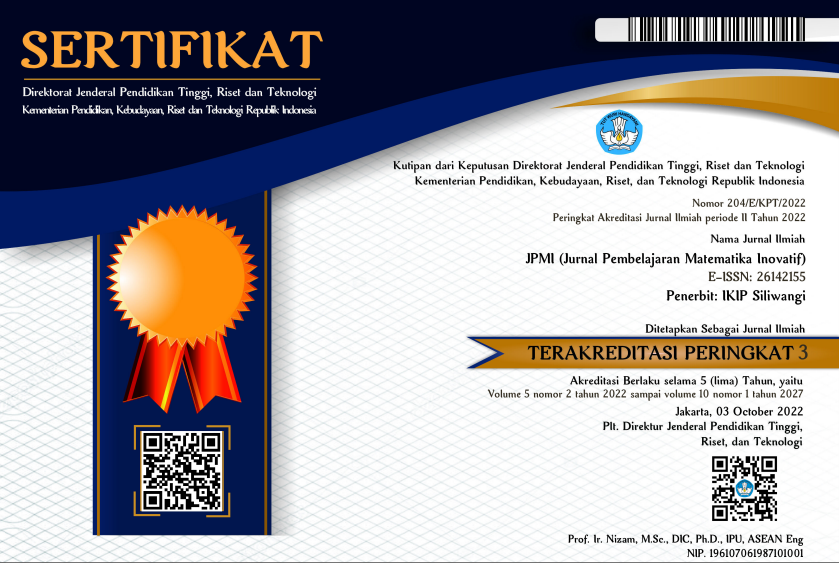KEEFEKTIFAN BAHAN AJAR MATEMATIKA TERHADAP KEMAMPUAN BERPIKIR KRITIS MATEMATIS SISWA SMP
DOI:
https://doi.org/10.22460/jpmi.v6i1.11212Keywords:
Effectiveness of Teaching Materials, Critical ThinkingAbstract
The use of important teaching materials in the implementation of learning. This research also aims to support mathematics learning to be more interactive and effective and to support student activities in the learning process to improve well. Student learning outcomes also focus on students’ mathematical critical thinking skills. Therefore, the purpose of this study was to determine the effectiveness of mathematic teaching materials on mathematical critical thinking skilss. The research method used in this study is experimental research, namely those obtained from observations, questionnaires and tests. The participants in this research were grade VI students of SMPN 2 Kertasari which consisted of 2 classes. The data analysis used in this research is descriptive analysis. The results of the study show three parts of effectiveness, namely the effectiveness of interaction showing 61% results with a moderately effective category, the effectiveness of understanding which shows 59% results in the moderately effective category and the effectiveness of teaching materials on mathematical critical thinking skills showing 62% results in the moderately effective category. Therefore, the use of mathematics teaching materials on mathematical critical thinking skills is quite good in its delivery and implementation.
References
Bahtiar, E. T. (2015). Penulisan Bahan Ajar. Bogor Agricultural University, https://doi.org/10.13140/RG.2.1.1441.6083
Gazali, R. Y. (2016). Pengembangan Bahan Ajar Matematika untuk Siswa SMP Berdasarkan Teori Belajar Uusubel. PYTHAGORAS: Jurnal Pendidikan Matematika, 11(2), 182–192. https://doi.org/10.21831/pg.v11i2.10644
Meiliana, L., & Aripin, U. (2019). Analisis kemampuan berpikir kreatif dan self regulated learning pada siswa SMPN 1 Margaasih. Journal on Education, 1(4), 644–652.
Nashrullah, F. R., Asikin, M., Waluya, B., & Zaenur. (2021). Kemampuan Berpikir Kritis Matematis Siswa pada Pembelajaran Realistic Mathematics Education. Jurnal Integral, 12(1), 1–18.
Nisa, Y. R., & Amelia, R. (2021). The Effectiveness of Mathematics Teaching Materials on Problem-Solving Ability Junior High School Students. (JIML) Journal of Innovative Mathematics Learning, 4(4), 198–208.
Nursyahidah, F., & Albab, I. U. (2018). Identifikasi Kemampuan Berpikir Kritis Matematis Mahasiswa Berkemampuan Pemecahan Masalah Level Rendah dalam Pembelajaran Kalkulus Integral Berbasis Problem Based Learning. Jurnal Elemen, 4(1), 34–49. https://doi.org/10.29408/jel.v4i1.513
Putra, E. D., & Amalia, R. (2020). Upaya Meningkatkan Kemampuan Berpikir Kritis Mahasiswa Melalui Pembelajaran Discovery Learning Berbasis Assessment Learning. Journal of Education and Learning Mathematics Research (JELMaR), 1(1), 57–64. https://doi.org/10.37303/jelmar.v1i1.17
Susilowati, S., Sajidan, S., & Ramli, M. (2018). Keefektifan perangkat pembelajaran berbasis inquiry lesson untuk meningkatkan keterampilan berpikir kritis siswa. Jurnal Penelitian Dan Evaluasi Pendidikan, 22(1), 49–60. https://doi.org/10.21831/pep.v22i1.17836
Syaifullah, M., & Izzah, N. (2019). Kajian Teoritis Pengembangan Bahan Ajar Bahasa Arab. Arabiyatuna : Jurnal Bahasa Arab, 3(1), 127–144. https://doi.org/10.29240/jba.v3i1.764
Wahyuni, N. (2019). Efektivitas Pembelajaran Dengan Menggunakan Metode Praktik untuk Mata Pelajaran Produktif Jurusan Administrasi Perkantoran Di SMK Nasional Makassar. Universitas Negeri Makassar, 1–8.
Downloads
Published
Issue
Section
License
Copyright (c) 2023 JPMI (Jurnal Pembelajaran Matematika Inovatif)

This work is licensed under a Creative Commons Attribution-ShareAlike 4.0 International License.
The author is responsible for acquiring the permission(s) to reproduce any copyrighted figures, tables, data, or text that are being used in the submitted paper. Authors should note that text quotations of more than 250 words from a published or copyrighted work will require grant of permission from the original publisher to reprint. The written permission letter(s) must be submitted together with the manuscript.
















